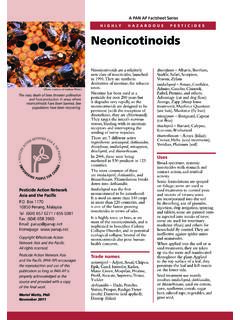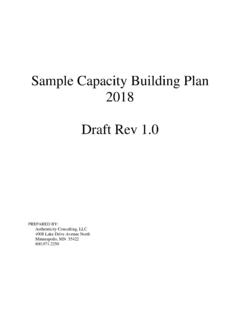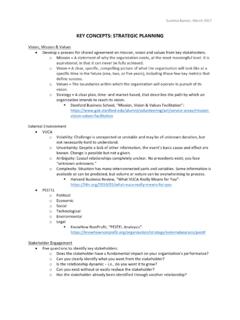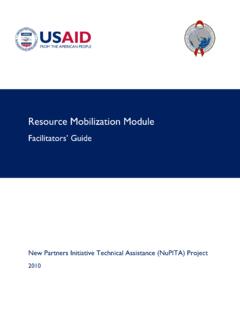Transcription of Strategic Communications Planning
1 You gotta have a Communications Planning The purpose of a Strategic Communications plan is to in-tegrate all the organization s programs, public education and advocacy efforts. By plan -ning a long-term strategy for your efforts, you will be posi-tioned to be more proactive and Strategic , rather than con-sistently reacting to the existing environment. The Strategic plan will help you deploy re-sources more effectively and strategically by highlighting synergies and shared opportu-nities in your various programs and work areas. The creation and adoption of a Strategic Communications plan represents a significant step for any organization. For many organizations, the adop-tion of such a plan represents a cultural shift toward communi-cations and a clear recognition that all the organization s ef-forts have a Communications element. Public education, grassroots organizing, research, public advocacy, direct service and even fundraising are all, at their core, Communications tasks vital to the health and success of a nonprofit the SPIN Project we firmly believe that a Strategic com-munications plan has the power to transform an organi-zation: both in terms of your credibility and status in your community, and in terms of the way you work together as a team to achieve your mission and vision for your community.
2 The Communications plan pyramid on the next page out-lines six questions you must answer before you even begin to implement your media tac-tics: 1. Assess your Communications Establish your goals. 3. Who is your target?4. Who is your audience? 5. What is your frame? 6. What is your message? Strategic Communications Planning 2005 The SPIN Project. Some rights reserved. 1 CONTENTS1 Strategic COMMUNI-CATIONSThe purpose of a plan2 THE PYRAMIDW orking from the ground up5 GET TO WORK! How to get your message out7 FOLLOW THROUGH Track and evaluate your work149 Natoma StreetSan Francisco, CA 94105phone Some rights reserved. This tutorial is licensed under a Create Commons license. You are free to use its contents for any non-commercial purpose, provided that you credit the SPIN plan TemplateUse this worksheet in conjunction with the Communications plan pyramid model to develop your com-munications strategy for a specific campaign.
3 This template follows the pyramid from the ground up. Step 1 Assess Past Communications Lessons LearnedWhat worked - describe your top three Communications wins and three worst blunders from the last two years. Step 2 Lay the Foundations of Winning CommunicationsCommunications Infrastructure What is your Communications capacity? How much staff time are you willing to devote to Communications ? If you feel you can not afford Communications staff, are there Communications Strategic Communications Planning 2005 The SPIN Project. Some rights reserved. 2 Communications InfrastructureEstablish your GoalsTarget your AudienceFrame the IssueDiscipline the MessageMediaTacticsTargetThe PyramidCommunications InfrastructureEstablish your GoalsTarget your AudienceFrame the IssueDiscipline the MessageMediaTacticsfunding opportunities on the horizon? Who will do the work are they comfortable with and knowledgeable about Communications ?
4 What is your program budget? If you do advocacy, are you willing to commit 30% of that to Communications ? How powerful is your brand? Is it well known? The answers to these questions are the foundation from which your communica-tions work will thrive or fail. Goals What are your program, campaign or organizational goals? Why are you launching Communications efforts in the first place? What, specifically, do you want to win? What is your positive vision for the future?Target Who can give you what you want? ( , councilper-son for District X) Can you directly influence this individual s deci-sion making? If not, who can? Who do you need on your side to get what you want? ( , voters in District X)Your Audience The people who can to persuade the decision maker to do what you want ( , voters in District X). Know your audience through research: Focus groups Surveys Door-knocking/canvassing Talking to strangers in the supermarket, on airplanes, the IssueDescribe the issue in a way that resonates with the values and needs of your audience, and is also in-teresting to journalists, or newsworthy.
5 What is this issue really about? Who is affected? Who are the players? What hooks does this frame contain? What pictures and images communicate this frame? Strategic Communications Planning 2005 The SPIN Project. Some rights reserved. 3 Communications InfrastructureEstablish your GoalsTarget your AudienceFrame the IssueDiscipline the MessageMediaTacticsCommunications InfrastructureEstablish your GoalsTarget your AudienceFrame the IssueDiscipline the MessageMediaTacticsCommunications InfrastructureEstablish your GoalsTarget your AudienceFrame the IssueDiscipline the MessageMediaTacticsCommunications InfrastructureEstablish your GoalsTarget your AudienceFrame the IssueDiscipline the MessageMediaTacticsFor Direct Service organizations: What image do you want your organization to convey? With what organizations, political positions and people do you want your organization to be associated?Craft and Discipline your MessageThe SPIN Project recommends a message made of the following three-part framework.
6 Each part should be no longer than 35 words. ProblemIntroduce your frame. Describe how your issue affects your audience and its broader impacts. SolutionSpeak broadly about the change you wish to see. Speak to peoples hearts with values-rich language and images. ActionCall on your audience to do something specific. Make sure key people in your organization buy into this message. Craft your message to be appealing to journalists and convincing to your target audience. Brainstorm soundbites, or spoken language that expresses much or all of your message in 7-12 seconds. Select and train spokespeople Who are the best messengers to reach your tar-get audience? Hint: the most powerful person in the organiza-tion is not always the best person to put on cam-era. Choose someone with an effective speaking style and a look that appeals to your audience. Have spokespeople practice delivering message on camera.
7 Review and critique the tape. Adjust the message if needed at this stage; something that works on paper may fail when you actually say it. Strategic Communications Planning 2005 The SPIN Project. Some rights reserved. 4 Communications InfrastructureEstablish your GoalsTarget your AudienceFrame the IssueDiscipline the MessageMediaTacticsCommunications InfrastructureEstablish your GoalsTarget your AudienceFrame the IssueDiscipline the MessageMediaTacticsStep 3 Get to work!Now that you know what you want to say and why, it s time to figure out how you re going to broadcast your message. The first step is to decide which local, re-gional, and national TV, radio, and print outlets will move your target audience to take the action your desire. Make a list of the top 20 outlets that would have the most impact for your strategy, ordered according to importance to your campaign. Next to the outlet name, list the journalist(s) there with whom you want to cultivate a rela-tionship and the type of piece in which you d like your organization featured.
8 Here are some examples of types of pieces to aim for: TV, Radio or Print News Story Op Ed Letter to the Editor Radio or TV Talkshow Appearance Magazine Feature StoryNow it s time to plan how to attract your targeted media outlets to cover your story and carry your message. plan along a realistic timeline events, products, story releases, and other tactics to get your message to your target audience. Recall the successes you recounted in Step 1, but don t let your past successes and failures restrain your imagination or Strategic sense. What will you pitch to the above outlets/reporters? What s the news you re providing them with? What are the hooks that make your news interesting to journalists? Choose from the list below and brainstorm your own: New Study/Report/Announcement Event/Anniversary Trend Localize a National Story Dramatic Human Interest Controversy Fresh Angle on Old Story Calendar Hook/Holiday Profile of Fascinating Person Response to Big News Story Celebrity Involvement Strategic Communications Planning 2005 The SPIN Project.
9 Some rights reserved. 5 Targeting ExamplesNote: This list does not need to include The New York Times and CNN; your local TV station or a Capitol Hill newsletter may be much more important to moving your campaign forward. Cleveland Plain Dealer News StoryRich Exner, Political Staff WriterOpEdLinda Maelstrom, Opinions EditorChannel 7 News (ABC)Evening News StoryKim Jones, Evening News ProducerChannel 34 News (Telemundo)Noon Talkshow SpotGeorge Melendez, HostOhio State Legislators NewsletterNews StoryJacob Jones, 20 or so outlets, depending on your organization s but not least, the details: What events and materials do you need to create to communicate with reporters? Media Events Simply holding a press conference is not enough unless the speakers include Ma-donna, George Bush or Barry Bonds. In-stead, create an event! Make it visual! Use props! Even if they feel a little awkward, they will often work on camera.
10 For example, if you re releasing a report about water quality, have scientists with lab coats and goggles take samples on camera. Be sure to inform journalists of the visual opportunities you re providing. Consider spending the money to hire a professional photographer to document your event. High quality photos are invalu-able for websites, brochures and in funder meetings. At any press event, be armed with Media Kits to hand to all reporters. These include: Media Advisories News Releases Fact Sheets Brief bios of spokespeople Organizational Brochure Your Business Card Note: All of these materials should be available on your website in an Online Press Room. Mediagenic MaterialsReporters will always appreciate the fresh information, compelling stories and authen-tic spokespeople your organization works can provide. Consider packaging and broadcasting your organizations findings and case studies in deliverables such as: Reports Polls Scorecards Top Ten Lists Strategic Communications Planning 2005 The SPIN Project.












